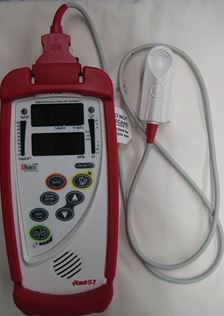- Clinical Technology
- Adult Immunization
- Hepatology
- Pediatric Immunization
- Screening
- Psychiatry
- Allergy
- Women's Health
- Cardiology
- Pediatrics
- Dermatology
- Endocrinology
- Pain Management
- Gastroenterology
- Infectious Disease
- Obesity Medicine
- Rheumatology
- Nephrology
- Neurology
- Pulmonology
Domestic Carbon Monoxide Exposure
Figure. Finger tip carboxyhemoglobin saturation monitor.

A 28-year-old woman presents with a headache and nausea, which have been persistent over the past 3 days. She has taken acetaminophen without relief. The patient denies any history of migraines, trauma, fever, upper respiratory symptoms, vomiting, visual changes, or auras. She has been eating and sleeping well and denies stress or depression. She says that the headache seems to get much better during the day when she is at work.
She has no significant past medical or surgical history. She takes only oral contraceptives and acetaminophen as needed for headaches, which typically are very infrequent. She admits to occasional tobacco and social alcohol use, but denies any other recreational drug use.
Medications: Oral contraceptives. Allergies: None. LMP: Currently
Vital signs: HR, 98 beats/min; oxygen saturation, 100% on room air
Physical including neurologicl exam is unremarkable.
1. What additional questions should be asked?
2. What diagnosis should be considered?
3. What tests, if any, should be performed?
Answers:
1. In addition to the typical questions asked pertaining to headaches, one should also consider infectious and possible toxic exposures. The fact that the headaches seem to only occur at home and improve when she leaves for work makes an infectious etiology less likely. The patient added that her roommate has also been experiencing headaches and nausea over the past 2 to 3 days.
2. Atypical headaches and nausea occurring in multiple individuals in the same area should prompt you to consider a possible toxic exposure such as carbon monoxide (CO) which is the third leading cause of unintentional poisoning in the United States.
CO affects several different sites within the body but has its most profound impact on the brain and heart. The most common symptoms of CO poisoning are headache, dizziness, and nausea. CO is a colorless, odorless gas that can cause sudden illness or death. CO is found in combustion fumes, such as those produced by cars and trucks, small gasoline engines, stoves, lanterns, burning charcoal and wood, and gas ranges and heating systems. CO from these sources can build up in enclosed or semi-enclosed spaces poisoning both people and animals.
3. Carboxyhemoglobin (HbCO) levels should be obtained and 100% high-flow oxygen via a tight-fitting mask be initiated and continued until the patient is asymptomatic and HbCO levels are below 10%. An ECG should be obtained and a urine HCG screen should be performed in all women of child-bearing age. CO toxicity causes impaired oxygen delivery and utilization at the cellular level and reversibly binds hemoglobin, resulting in relative functional anemia. Because it binds hemoglobin more than 200 times more avidly than oxygen, even small concentrations can result in significant levels of HbCO.
Consider immediate transfer of patients with HbCO levels above 40% or cardiovascular or neurologic impairment to a facility with hyperbaric oxygen capabilities. New pulse CO-oximetry units are available (Figure) that can screen for CO toxicity at the bedside and may provide a more rapid diagnosis and initiation of hyperbaric oxygen therapy than laboratory CO-oximetry.
References:
American College of Emergency Physicians, Clinical Policy: Critical Issues in the Management of Adult Patients Presenting to the Emergency Department with Acute Carbon Monoxide Poisoning. Available at: http://www.acep.org/clinical---practice-management/clinical-policy--critical-issues-in-the-management-of-adult-patients-presenting-to-the-emergency-department-with-acute-carbon-monoxide-poisoning
